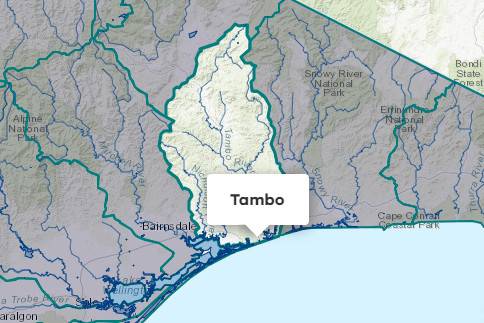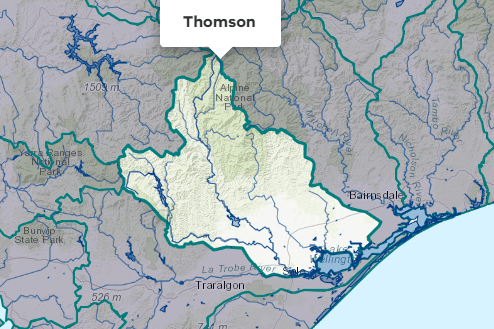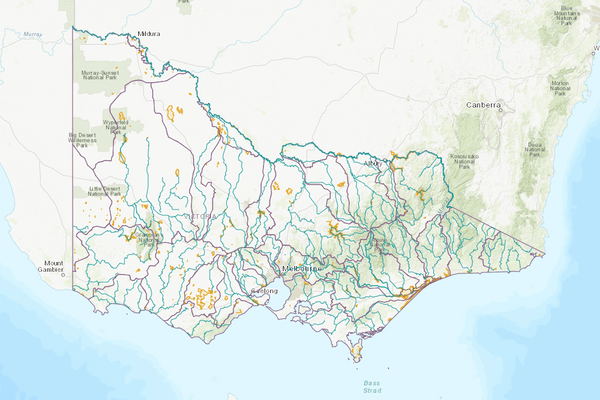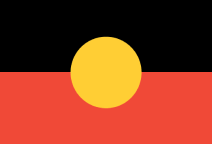About the area
The Mitchell River begins at the confluence of the Wonnangatta and Dargo Rivers below the Dargo township and ends as it flows into the Gippsland Lakes. The Wentworth River is another tributary of the Mitchell.
The upper basin is predominantly forested and includes sections of the Alpine National Park and Mitchell River National Park, although there are small areas of cleared land along the Dargo and Wonnangatta Rivers.
Annual rainfall varies from 600-900 mm in the southern half of the basin to over 1200 mm in the north.
More information on water management and accounting is detailed in Water explained.
2023-24 overview
Available water
Catchment inflow was lower than the previous year.
Licensed diversion restrictions
There were more restrictions on licensed diversions than the previous year.
Water use
More water was diverted for consumptive purposes than the previous year.
When compared to the previous year, in 2023-24:
- less rainfall was received, and catchment inflows were lower
- there were more restrictions on licensed diversions from streams
- more water was diverted from the basin for consumptive uses.
Climate
Rainfall
In 2023-24, less rainfall was received in the Mitchell basin than the previous year. Rainfall was:
- above average in a small area in the south-west along the border with the Thomson basin
- below average in the far north-east corner, south of Hotham Heights
- average in the rest of the basin.
Figure 1 displays the rainfall received in 2023-24 compared to the long-term average (1975-2024).
Figure 1: Rainfall deciles, Mitchell basin
Sourced from the Australian Bureau of Meteorology
River basin water balance
This section describes the known and estimated inflows, outflows and change of storage volumes in the basin.
More detail on catchment inflows, diversions and small catchment dams can be found in the sections below the water balance.
Consumptive use in the basin is low compared to the total water resource. About 88% of the total inflows were not diverted and flowed through to the Gippsland Lakes.
Water balance table
The table below shows the total volumes of water available and supplied from water resources in the Mitchell basin in 2023-24.
Table 1: Water balance, Mitchell basin
Inflows
Catchment inflow
Catchment inflow represents the volume of water flowing into the waterways of a basin. It is calculated as the total outflows and change in storage minus, the known inflows. The long-term average inflow presented has been updated from the previous Victorian Water Accounts, as detailed in Water Explained. The updated long-term average inflow has been applied to this year and the previous year’s volume in this report.
Above average inflows of 902,571 ML were received (112% of the long-term average of 809,200 ML), less than the previous year (159% of the long-term average).
Above average inflow received
Catchment inflow was 112% of the long-term average (809,200 ML).
Less water received than last year
Catchment inflow was lower than the previous year (159% of the long-term average).
Wastewater treatment plants
Water treated at wastewater treatment plants can be used to supplement water available in the basin. Water discharged to waterways from treatment plants is included as an inflow to the water balance.
Information on treatment plants is reported in the water supply local reports for the water corporation responsible for managing the plant.
In this basin, wastewater treatment plants are managed by East Gippsland Water.
Outflows
Diversions
In 2023-24, 14,866 ML of water was diverted for consumptive uses: town, domestic and stock, irrigation and commercial supply. This was more than the volume diverted in the previous year (10,756 ML).
Small catchment dams
Water harvested, used, and lost by small catchment dams (farm dams) is included in the water balance.
Table 2: Small catchment dams, Mitchell basin
Entitlements and compliance
Entitlements provide the basis for how water is shared in the basin.
Entitlement volumes
Rights to water in the Mitchell basin are shown in Table 3.
Entitlement volumes represent a maximum volume of water that can be taken in a one-year period. The volume available in a particular year is dependent on the rules for allocating water set out in the entitlement and the seasonal conditions in that year, which can vary. The rules for allocating water under an entitlement differ between entitlements and systems. This affects the ability and likelihood of water being taken in a particular year.
Table 3: Annual entitlement volumes at 30 June, Mitchell basin
Available water and take under entitlements
Total water available under entitlements represents the volume of water that was available to be taken by entitlement holders in 2023-24. The volume includes carryover from the previous year, seasonal allocations and net trade into the basin.
Water taken
There was 13,987 ML taken under entitlements in 2023-24, more than the previous year (9,933 ML).
Restrictions on licensed diversions from streams
- There were restrictions on licensed diversions from the Mitchell River between August to September 2023 compared to no restrictions during the previous year.
- All other streams were unrestricted during 2023-24.
Available water and take table
This table shows the volume of available water and the volume taken under entitlements in 2023-24.
More information on available water and take has been detailed in How we account for surface water.
In 2023-24, more water was taken under entitlements than the previous year.
Table 4: Available water and take under entitlements, Mitchell basin
Compliance
Compliance against water entitlements is reported for this basin in 3 areas:
- entitlement issued: that the volume of entitlements issued in a basin does not exceed formal caps, and has not increased without appropriate approvals
- water taken: that the volume of water taken during the year does not exceed the volume considered to be available for consumptive and/or in-stream use during that year
- bulk entitlement provisions: that holders of entitlements do not breach any provisions that are documented in their bulk entitlement orders.
Total entitlement volume
There was no net increase in the total entitlement volume from the previous year.
Total volume diverted
The total volume diverted under entitlements (13,987 ML) was within the volume available for the year (32,359 ML).
Individual bulk entitlements
No individual bulk entitlement holder took more than the annual volume made available to them.
Exceptions to compliance
Individual bulk entitlement holders complied with all provisions in their entitlements.
Water for the environment
Environmental watering sites
There are no environmental entitlements in the Mitchell basin, so no active environmental watering occurs.
However, important sites and environmental values in the Mitchell basin that depend on water for the environment include:
- the Gippsland Lakes, which are listed as internationally significant wetlands under the Ramsar Convention and partially rely on freshwater inputs from the Mitchell basin to function ecologically
- the Mitchell River, which has a long estuary reach extending from the old barrier upstream of Bairnsdale to where the river enters the Gippsland Lakes at Lake King via the internationally significant silt jetties; there are important wetlands on both sides of the river including Macleod Morass, Jones Bay and the Lake King Wetlands at Eagle Point
- heritage river reaches, fish populations (including Australian grayling and black bream), waterbirds (for example, the great egret) and botanical values (for example, yellowwood).
Environmental water reserve
In 2023-24, water for the environment in the Mitchell basin comprised:
- water set aside for the environment through the operation of passing flow conditions on:
- the consumptive bulk entitlement held by East Gippsland Water
- licensed diversions
- all other water in the basin not allocated for consumptive uses: this water also provides social, recreational and cultural benefits.
Management responsibilities
Management of water in the Mitchell basin is undertaken by various parties
| Authority | Management responsibilities |
|---|---|
| East Gippsland Catchment Management Authority |
|
| East Gippsland Water |
|
| Southern Rural Water |
|
| Water supply system | 2022-23 (ML) | 2023-24 (ML) |
|---|---|---|
| Mitchell System | 4,093 | 4,388 |






